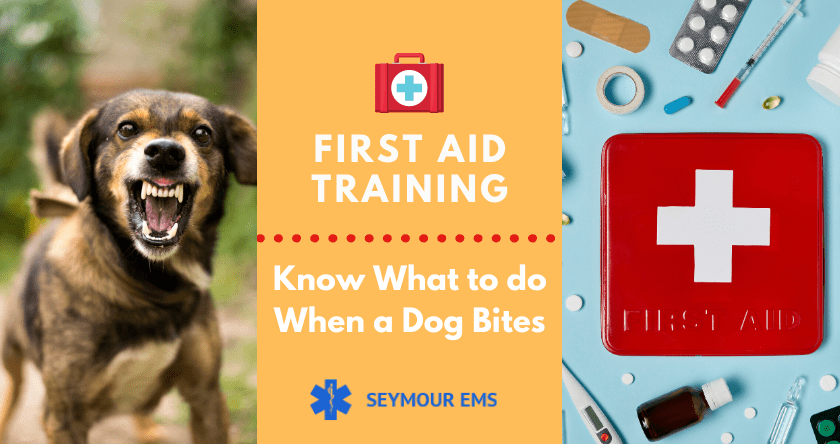It is a fact of life that dogs bite. Approximately 4.7 million bites inflicted by dogs on people are reported in the US every single year. Although these statistics sound grim, at least 80% of these bites only result in minimal injury and can be treated by someone with basic first aid training.
First Aid Training: Evaluate the bite
Stop the bleeding
These types of injuries are usually inflicted on the face, hands/arms, or legs, all areas that tend to bleed copiously. If possible, elevate the affected area and apply a cold, clean towel with pressure until the bleeding slows or stops. The cold will help the blood vessels to contract, so if an ice pack or bag of frozen peas is available, wrapping it in the towel before an application can speed both blood coagulation and reduce bruising to the area.
Clean the bite
The most important aspect of treating a bite is to prevent infection. Dog’s canine teeth tend to make puncture wounds, and puncture wounds can easily become contaminated with bacteria. The second step in treating a bite is to wash it out very well with warm water and soap. If possible, let warm water run over the injury for a full five minutes to flush away any bacteria. Then, apply an antibiotic ointment and cover the wound with a sterile dressing. Wash the wound daily and reapply antibiotic ointment before replacing the dressing. Most minor bite wounds on healthy people heal quite rapidly.
First Aid Training: When to go to the ER
Arterial bleeding
If the blood is squirting out in a pulsing fashion, an artery has been severed. Call 911, apply pressure to the wound, and if someone is available who have taken first aid training and knows how and where to apply pressure to the correct artery point, go ahead and do so while waiting for the ambulance.
Shock, severe damage, and heavy bleeding
If the victim loses conscious, seems very confused, feels cold and clammy to the touch, or the bleeding cannot be stopped after a reasonable period of applying pressure to the wound, proceed directly to the nearest emergency room. If the damage to the victim seems to go far beyond a simple bite and is better characterized as a mauling, again, call an ambulance or proceed directly to the nearest emergency room.
First Aid Training: When to see a doctor about a simple bite
Rabies
The vast majority of bites are inflicted by dogs well-known to the victim. In such cases, it is essential to confirm the dog is up-to-date on its rabies shots. If the dog is unknown to the victim, it is essential to consult a doctor about whether prophylactic rabies shots may be necessary; the doctor will report the bite to the authorities and they may make an effort to locate the dog and either identify the owners to confirm its rabies vaccination status or capture and quarantine the dog to confirm its rabies status.
Does it need stitching?
If the wound is on the face, especially on a child’s face, getting the wound sutured by a plastic surgeon may prevent visible scarring from forming. Bites located on other parts of the body are rarely sutured; doctors feel that allowing puncture wounds to drain freely can help prevent infection. However, if a flap of skin has been torn loose, the doctor will probably suture it back into place.
Susceptible victims and very deep wounds
If the wound is fairly extensive or very deep, or if the victim has a health problem that suppresses the immune system and/or healing, it is essential to consult a doctor. Health problems of concern include diabetes, liver disease, uncontrolled HIV infection, being treated with chemotherapy/radiotherapy, or taking immunosuppressants. In all of these cases, the doctor may decide to re-clean the wound and prescribe oral antibiotics.
What about the dog?
Once a simple bite has been treated with first aid, many dog owners now wonder if they need to do anything with the dog. Questions to consider include whether the dog was provoked; often the answer is a glaring Yes by dog experts and a puzzled No by the average pet dog owner. Consider talking to a dog behaviorist about the incident in order to better understand what happened and why, and how to prevent it from happening again in the future through training and/or better management.


Recent Comments